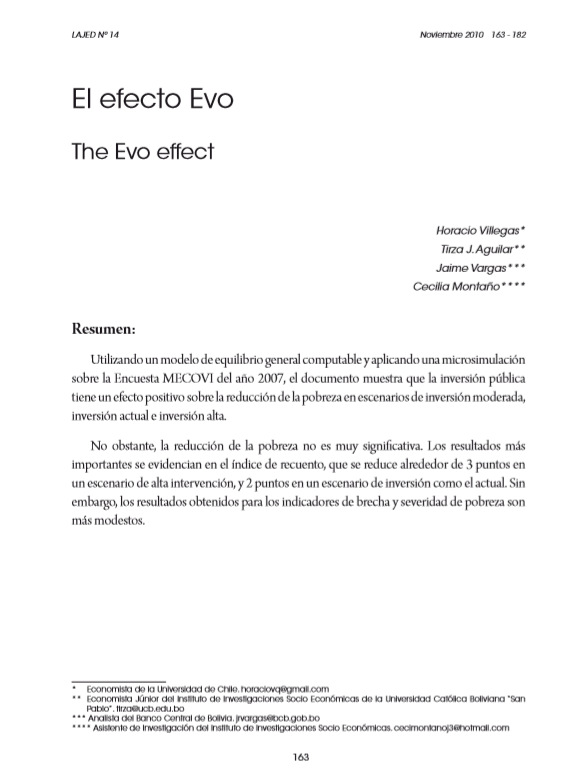The Evo effect
DOI:
https://doi.org/10.35319/lajed.201014362Keywords:
Poverty, Public Investment, General Computable Equilibrium Model, Headcount Index, Breach, Severity, MECOVI.Abstract
Using a General Computable Equilibrium Model and applying a microsimulation on MECOVI Survey of 2007, the document shows that the public investment has a positive effect on the poverty reduction in a moderate, present and high investment scene. However, the poverty reduction is not too significant. The most important results are demonstrated in the headcount index, it reduced around 3 points in a scene of high intervention and 2 points in a scene of investment like the present one. Nevertheless, the results obtained for the breach indicators and severity of poverty are more modest.
Downloads
References
Agénor, P.R ., A. Izquierdo y H. Fofack. 2002. “IMMPA: A Quantitative Macroeconomic Framework for the Analysis of Poverty Reduction Strategies”. The World Bank, Washington, D.C., pp. 3-12.
Anderson, Edward, Paolo De Renzio y Stephanie Levy. 2006. “The Role of Public Investiment in Poverty Reduction: Theories, Evidence and Methods”. Working Paper 263, Overseas Development Institute.
Armington, P. 1969. “A Theory of Demand for Products Distinguished by Place of Production”. Documento de Staff, Fondo Monetario Internacional, Vol XVI, No. 1, pp. 159-178.
Bourguignon, F., W. Branson y J. De Melo. 1989. “Adjustment and Income Distribution: A Counterfactual Analysis”. Documento de Trabajo No. 2943, National Bureau of Economic Research, Cambridge, MA.
Decaluwé, B. y A. Martens. 1988. “CGE modeling and developing economies: A concise empirical survey of 73 applications to 26 countries”. Journal of Policy Modeling, 10, pp. 4-12.
Dewatripont, M. y G. Michel. 1987. “On Closure rules, homogeneity and dynamics in applied general equilibrium models”. Journal of Development Economics, 26, 65-76.
Dervis, K ., J. de Melo y S. Robinson. 1982. “General Equilibrium Models for Development Policy”. Cambridge, Cambridge University Press.
Dixon, P.B., B.R . Parmenter, J. Sutton y D.P. Vincent. 1982. “ORANI: a multi-sectoral model of the Australian Economy”. Documento de Trabajo No 1/06, Universidad de Melbourne. Melbourne.
Easterly, W. 2001. “The Elusive Quest for Growth: Economists’ Adventures and Misadventures in the Tropics”. London: MIT Press.
Foster, James, Joel Greer y Erik Thorbecke. 1984. “A Class of Decomposable Poverty Measures”. Econometrica, Vol. 52, No. 3, The Econometric Society.
Ginsburgh, V. y M. Keyzer. 1997. “The structure of applied general equilibrium models”. The MIT Press, Cambridge, Mass.
Horridge, J.M., B.R . Parmenter y Pearson K .R . (1993). “ORANI-F: A General Equilibrium Model of the Australian Economy”. Economic and Financial Computing , 3, pp. 71-140.
Jemio, L.C. 1993. “Microeconomic and Macroeconomic Adjustment in Bolivia (1970-89). A Neostructuralist Analysis of External Shocks, Adjustment and Stabilization Policies”. Tesis Doctoral, Institute of Social Studies. The Hague.
Jemio, L.C. y E. Antelo. 1999. “Una visión sobre las perspectivas de crecimiento de la economía boliviana a partir del modelo de tres brechas”. Documento de Trabajo, Unidad de Análisis de Políticas Económicas. La Paz.
Jemio, L.C. 2001. “Macroeconomic Adjustment in Bolivia since the 1970s: Adjustment to What, By W hom, and How? Analytical Insights from a SAM Model”. Kiel Working Paper 1031, The Kiel Institute of World Economics. Kiel.
Lay, Jann, Rainer Thiele y Manfred Wiebelt. 2008. “Shocks, Policy Reforms and Pro-Poor Growth in Bolivia: A Simulation Analysis. Review of Development Economics, 12(1), 37–56.
Little, I. y J. Mirrless. 1994. “The Costs and Benefits of Analysis: Project Appraisal and Planning Twenty Years on”. En: R . Layard and S. Glaister, Cost Benefit Analysis. Cambridge (Chapter 6). Cambridge University Press.
Nunnenkamp, Peter, Rainer Schweickert y Manfred Wiebelt. 2007. “Distributional Effects of the FDI: How the Interaction of FDI and Economic Policy Affects Poor Households in Bolivia”. Kiel Institute for the World Economy.
Pereira, A. y J. Shoven. 1988. “Survey of Dynamic Computational General Equilibrium Models for Tax Policy Evaluation”. Journal of Policy Modeling, 10, 3. pp. 2-11.
Rattso, J. 1982. “Different Macroclosures of the Original Johansen Model and Their Impact on Policy Evaluation”. Journal of Policy Modeling, Vol IV, 85-97.
Rosensweig , J. A. y L. Taylor. 1990. “Devaluation, capital flows and crowding out: a CGE model with portfolio choice for Thailand”. En: L. Taylor (ed.): Socially Relevant Policy Analysis: Structuralist Computable Equilibrium Models for the Developing World. The MIT Press, Cambridge MA, pp. 302-332.
Shoven, J. y J. W halley. 1992. “Applied General equilibrium Analysis”. Cambridge: Cambridge University Press.
Silva, A. 2004. “Monetary Dynamics in a General Equilibrium Version of the Baumol-Tobin Model”. Documento de Trabajo, Universidad de Chicago, pp. 4-11.Chicago.
Taylor, L. 1990. “Structuralist CGE Models”. En: L. Taylor (ed.). Socially Relevant Policy Analysis: Structuralist Computable General Equilibrium Models for the Developing World. The MIT Press, Cambridge MA, pp. 1-70.
Thiele, R . y D. Piazolo. 2002. “Constructing a Social Accounting Matrix with a Distributional Focus. The Case of Bolivia”. Kiel Working Paper 1094, The Kiel Institute of World Economics. Kiel.
Thiele, R . y D. Piazolo. 2003. “A Social Accounting Matrix for Bolivia Featuring Formal and Informal Activities”. Latin American Journal of Economics, Nº 40, pp. 1-34.
Thiele, Rainer y Manfred Wiebelt. 2003. “Attacking Poverty in Bolivia – Past Evidence and Future Prospects: Lessons from a CGE Analysis”. Documento de Trabajo No. 06/03, Instituto de Investigaciones Socio Económicas (IISEC).
Thurlow, J. y D.E. Van Seventer. 2002. “A Standard Computable General Equilibrium Model for South Africa”. Documento de Trabajo No 100, International Food Policy Research Institute, Trade and Macroeconomic Division. Washington D.C.
UN Millennium Project. 2005. Investing in Development: A Practical Plan to Achieve the Millennium Development Goals. London: Earthscan.
Unidad de Análisis de Políticas Sociales y Económicas (UDAPE) y Comité Interinstitucional de las Metas de Desarrollo del Milenio (CIMDM), “Quinto informe de progreso de los Objetivos del Milenio en Bolivia”.
World Bank (1997). “Adjustment mechanisms. The real side”. Structuralist Macroeconomics. pp.3-16






